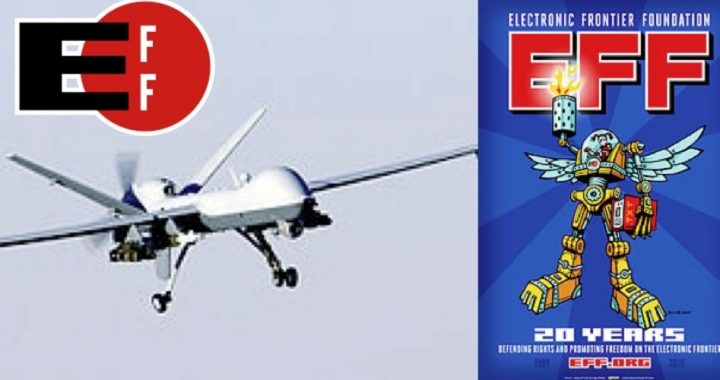
Despite assertions by the federal government that domestic drones would not be used to spy on Americans, government documents seem to tell another story. A Freedom of Information request filed by the Electronic Frontier Foundation has revealed documents by the Federal Aviation Administration, a component of the Department of Transportation, that give strong indication the drones will be used for surveillance purposes.
In April of 2011, the EFF filed a Freedom of Information request on the use of the drones, but the Department of Transportation failed to release the information requested. The EFF then filed a lawsuit against the department in January “demanding data on certifications and authorizations the agency has issued for the operation of unmanned aircraft, also known as drones.” Certifications by the FAA are required for anyone who wishes to operate a drone in the United States over 400 feet.
In its complaint in the lawsuit, the EFF wrote,
There is currently no information available to the public on which specific public and civil entities have applied for, been granted or been denied certificates or authorizations to fly unmanned aircraft in the United States.
[The EFF] has exhausted the applicable administrative remedies with respect to its FOIA request referenced herein, [but the DOT] has wrongfully withheld the request records from [the EFF].
Jennifer Lynch, the EFF staff attorney who filed the suit, said in a statement that the use of drones for non-military purposes is “raising significant privacy concerns.” She added,
Drones give the government and other unmanned aircraft operators a powerful new surveillance tool to gather extensive and intrusive data on Americans’ movements and activities. As the government begins to make policy decisions about the use of these aircraft, the public needs to know more about how and why these drones are being used to surveil United States citizens.
Months later, that lawsuit helped to uncover 125 drone certificates and accompanying documents from the FAA totaling thousands of papers. It also revealed all the entities licensed to fly domestic drones, which include police departments from Seattle, Washington, to Little Rock, Arkansas, as well as 10 public colleges and universities, and several federal agencies such as the USDA and the Department of Energy.
The EFF reports that a cursory glance at the technology of the drones reveals that the most notable finding is that the prime purpose of the unmanned vehicles is surveillance:
With some exceptions, drone flights in the U.S. have been all about developing and testing surveillance technology. The North Little Rock Police Department, for instance, wrote that their SR30 helicopter-type drone “can carry day zoom cameras, infrared cameras, or both simultaneously.” Not to be outdone, the Seattle Police Department’s drone comes with four separate cameras, offering thermal infrared video, low light “dusk-dawn” video, and a 1080p HD video camera attachment. The Miami-Dade Police Department and Texas Department of Public Safety have employed drones capable of both daytime and nighttime video cameras, and according to the Texas Department of Public Safety’s Certificate of Authorization (COA) paperwork, their drone was to be employed in support of “critical law enforcement operations.”
While the release of the documents is a major step in the right direction, the EFF indicates that there must be more “transparency” around the use of the drones for domestic surveillance. The EFF has teamed up with MuckRock to encourage Internet users to join in the fight for more transparency.
MuckRock writes:
The Electronic Frontier Foundation and MuckRock have partnered to create a national project that helps anyone openly file and track public records requests which can answer just these questions, providing spot checks across America on which agencies and departments are planning, deploying or budgeting for drone deployments now or in the future. It’s a national census for government drone usage, and we need your help. It will only take a minute, and can be, if you choose, done anonymously.
Muckrock will file the information requests on behalf of interested users. Any information provided as a result of the requests will be filed publicly and tracked on the DroneWatch page.
When EFF first filed the lawsuit against the DOT, EFF attorney Lynch wrote,
Predator drones can eavesdrop on electronic transmissions, and one drone unveiled at DEFCON last year can crack Wi-Fi networks and intercept text messages and cell phone conversations — without the knowledge or help of either the communications provider or the customer. Drones are also designed to carry weapons, and some have suggested that drones carrying weapons such as tasers and bean bag guns could be used domestically.
Many drones, by virtue of their design, their size, and how high they can fly, can operate undetected in urban and rural environments, allowing the government to spy on Americans without their knowledge.
Meanwhile, documents obtained by the Center for Investigative Reporting reveal that the privacy issue is just one of a number of concerns related to the use of unmanned aerial vehicles. The Center explains:
Under pressure to open the nation’s skies to drone flights, federal regulators are relying on decades of aviation rules that imagined a human being in the cockpit — not an onslaught of remotely piloted aircraft — prompting questions about whether federal flight rules for drones are strong enough to prevent accidents and midair collisions, recently released documents show.
Congressional investigators report that there were over 200 drone accidents in Iraq and Afghanistan over the course of four years as a result of “material issues.”
Federal documents show that any efforts to make the operation of drones safer would cost billions of dollars. Several years ago, the FAA predicted that a system that could avoid collisions for drones could cost as much as $2 billion and would take years to develop.




